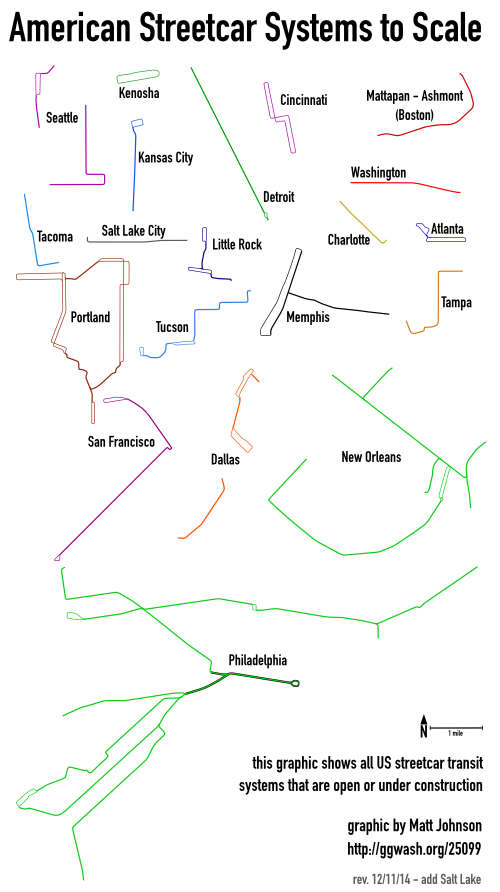See America’s streetcar systems at the same scale
Ever wondered how the DC Streetcar line on H Street will stack up to its American peers? Here’s a map that shows all the streetcar systems that are open or under construction in the United States.
Nineteen cities in America have streetcars that are either operating or under construction as a part of their transit systems. You can see all of them above at the same scale.
The largest system, in Philadelphia, is an upgraded version of the remnants of their original system. Most of the lines that survived because they fed into the Market Street subway, making them hard to bustitute.
Aside from new cars, these lines look much like they did in the 1960s, when many other cities still had streetcars. The Girard Avenue Line, which doesn’t feed into the subway, uses rehabilitated PCC cars, which SEPTA returned to service in 2005 after a 13-year bustitution.
Two other lines still have tracks and wires but have been “temporarily” bustituted since 1992. Those lines are not shown in the graphic above, since their return looks unlikely, at least in the near future.
New Orleans is another city that never completely got rid of streetcars. The St. Charles Line has been operating since 1835, making it the oldest continuously operating streetcar line in the world. It uses cars that have gone relatively unchanged since being built in 1923 and 1924. New Orleans’ newer other lines use recently-built replica cars on new track, though the Canal Line does follow the same route as a line that was discontinued in 1964.
Two cities, Seattle and Dallas, will have disconnected lines when their second lines open next year. In the graphic above, the lines are, relative to scale, as far apart as they will be in real life.
The other systems are a mix of modern and “heritage” equipment. San Francisco, for instance, uses restored cars from a variety of cities to operate their F Line along Market Street and the Embarcadero. On the other hand, Tampa and Little Rock have streetcar lines that use replica cars that look historic but which were actually built in the modern era.
The more recent trend, however, is to use modern vehicles. Portland started the trend in the United States when it opened its modern streetcar line in 2001, and since then modern lines have opened in Seattle, Tacoma, and Tucson. Modern streetcar lines are under construction in several other cities, including Washington.
I did not show the light rail systems in San Francisco (the Muni Metro) and Boston (the Green Line), though both are descendants of historic streetcar systems. They have a lot in common with the Philadelphia Subway-Surface trolley lines, but their upgrades put them more in the light rail category than the operation in Philadelphia.
The Sugar House “Streetcar” in Salt Lake City is really a light rail service, though it’s branded as a streetcar by the agency. Since it runs in an exclusive right-of-way and uses the same vehicles as the rest of Salt Lake’s light rail system, I did not include it in the map. Update: I’ve decided to include the Sugar House line based on the comments. I updated the graphic.
I also did not show the various tourist-oriented lines that only operate on weekends. While you can ride streetcars in a few other cities, like Savannah, the limited hours of operation means that these are not really transit lines.
Update: Based on the comments in the thread, I’ve revised the graphic to include the Sugar House Streetcar in Salt Lake City.

